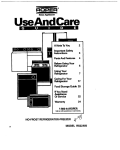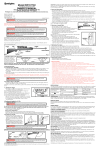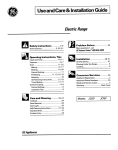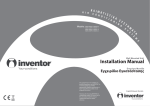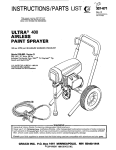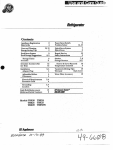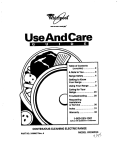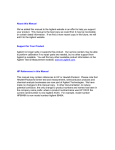Download Chicago Electric 95629 Assembly and Instruction manual
Transcript
S8C Switch Operators - Type CS-1A INSTRUCTIONS For Installation ITABLE OF CONTENTS I Section Page Number Section ............................. 1 INSTALLATION . . . . . . . . . . . . . . . . . . . . . . . . . . . . . .4 MANUAL OPERATION . . . . . . . . . . . . . . . . . . . . . . . . . .8 INTRODUCTION Page Number ADJUSTMENTS ............................ INSPEGIlON SCHEDULE AND PROCEDURES CHECKING SWITCH OPERATOR AND CIRCUIT-SWITCHERPOSITIONS . . . . . . . . .IO . . . . . . . . . .18 . . . . . . . . . .21 I I iTRODUCTjON maximum. It is expressly designed for power operation of S&C Circuit-Switchers-Mark V, as indicated in the table below. High-speed, high-torque poweroperation ofS&C Circuit-Switchers-Mark V, by means of the S&C Switch 0perator”Type CS-lA, is essential in order to attain thetwo-timeduty-cyclefault-closingratings of 30,000 amperesrmsthree-phasesymmetrical, 76,500 amperespeak for Vertical-Break Style and Integer Style models; and two-time duty-cycle faultclosing ratings of 40,000 amperesrmsthree-phase symmetrical, 102,000 amperes peak for Center-Break Style models. The equipment covered by this publication must be selectedfor a specific application and it mustbe installed,operated, and maintainedbyqualified personswho arethoroughlytrainedandwho understand any hazards that may be involved. This publication is written only for such qualified persons and is not intended to be a substitute for adequate training and experience in safety procedures for this type of equipment. The S&C Switch Operator-me CS-1A is a high-speed operator having anoperatingtime of 1.5 seconds SWITCH OPERATORS-Type CS-1A Application High-Voltage Device Style and Rating of High-Voltage Device sac Integer, 34 5 thru 69 kv Mark V+ Circuit-Switcher wlthout Shunt-Trip Devlce S&C Mark V+ Circult-Switcher wlth Shunt-Trip Devlce Vertlcal-Break, 34.5 thru 161 kv Center-Break, 230 and 345 kv, 3 gaps Minimum Motor Locked-Rotor Maximum and at Rated Control Time, Control Voltage, Seconds@ Voltage Inch-Lhs. 1.5 48 21 500 125 v dc 15 21 500 l5 6o hz 1.5 18 000 1.5 21 500 v dc - Ac~lerating TorqueCatalog Operating Number Current, Amperes 38845R4-A 30 38845R4-0 80 Schematic Wiring Diagram Drawing Number CDRBl12R2 CDR-3123R2 38845R4-D Integer, 34 5 thru 69 kv Vertlcal-Break, 34,5 thru 161 k v Center-Break, 230 and 345 kv, 3 gaps CDR-3183 38846R5-AHP 80 v dc 125 v dc 30 38846R5-0. CDR-3184A 1 0 Basedonminimumbatteryandexternalcontrolwire-sizeCatalog Number 38858Rl-B, for applications where the Circuitrequirements specified in S&C Data Bulletin 719-60; operatmg time Switcher is used in conjunction with an S&CAutomatic Control Device, will be less iflarger-than-minimum batterysize and/or external control unless the switch operator is ordered with the optional Shunt-Trip Contactor and Time-Delay Relay accessory, Catalog Number Suffi wire size is utilized for use with ‘-HI‘.” Inthisinstance,thecatalognumber is 38846R5-BHP. + The Type cs-IAswitch operator is also equivalentmodels of Mark 11, Mark 111, and Mark IVCircuit-Swtchers. CDR-3183forCatalogNumber 38846R5-BHP. CDR-3195 for Catalog Number38858R1-B. * Supersedes lnstructlon Sheet 719-500 dated 70-28-85 @1993 INSTRUCTION SHEET S&C ELECTRIC COMPANY Chicago CANADA ELECTRIC S&C LTD. September Toronto 7 1gm50o Page 1 of 21 7,1993 S&C Switch Operators - Type CS-I A I 1 INTRODUCTION - Continued Power operation of S&C Circuit-Switchers-Mark V, by means of the S&C Switch Operator--Type CS-lA, also provides opening and closing without hesitation under %-inch ice formation for Vertical-Break and Integer Style models, 1%-inchice formation for CenterBreak Style models; close interphase simultaneity, long life of fault-closing contacts under normal operating duties; and avoidance of excessive switching transients due toprolonged or unstable prestrikearcing. Because of its high-speed operation, the S&C Switch Operator-Type CS-1A is notsuitable for usewith switches of other manufacture. For6-gap S&C Circuit-Switchers, the S&C Switch Operator-Type CS-2A is required. and Type G, For S&C Circuit-Switchers-TypeA Vertical-Break Style, having reciprocating operating mechanisms, the S&C Switch Operator-Type CS-10 is required. For S&C Alduti-Rupters Switches-Outdoor Distribution and S&C Alduti-Rupter Switches with Power Fuses-Outdoor Distribution, S&C Switch OperatorsTypes AS-1A and AS10 are available. For S&C Line-Rupters’”, the S&C Switch OperatorType LS-2 is available. For switches of other manufacture, the S&C Switch Operator-Type LS-1 is available. The LS-1 is a lowspeed operator with an operating time of 4 to 7 seconds. It is designed for power operation of outdoor highvoltage disconnects and interrupter switches for which this low operating speedis appropriate. 7 1gm50oINSTRUCTION Page 2 of 21 September 7,1993 S&C Switch Operators--TypeCS-1A includethe following features as standard: Built-in internal decoupling mechanism,operable by integral external selector handle, with padlocking provisions andautomaticmechanical locking of output shaft. Laminated safety-plate window permits %ible air-gap” verification of complete disengagement of output shaft. Open-close pushbuttons, externally operable, with padlockable cover. Built-in nonremovable, foldaway manual operating handle. 0 Mechanicalpositionindicatorsforbothswitch operator and Circuit-Switcher “open” and “closed” positions. Non-reset electric operation counter. 0 Laminatedsafety-platewindow for inspection of built-in internal decoupling mechanism, mechanical position indicators, and operationcounter(and position-indicating lamps, if furnished as accessories). Foolproofrecoupling.Impossiblewithpositionindexing drums to couple the switch operator and the Circuit-Switcher “unsynchronized.” 0 Fingertipprecisionadjustment of output-shaft rotation using self-lockingspring-biased cams. 0 Eight-pole auxiliary switch, coupled to motor, with fingertip precision adjustment of individual contacts using self-lockingspring-biased cams. SHEET S&C ELECTRIC COMPANY Chicago S&C ELECTRIC CANADA LTD. 0 Toronto ermostat I INTRODUCTION - Continued Antifrictionbearings throughout;tapered roller bearings for all high-torque gear-train shafts. Two-pole pull-outfuseholdersformotor,spaceheater, and(if applicable) shunt-trip circuits. Weatherproof, dustproof enclosure, equipped with 120/240-volt ac space heater, factory-connected for 240-volt acoperation.Canreadilybefieldreconnected for 120-volt ac operation. Tamper-resistant design-welded enclosure; baffled louvers; gasketed, flanged door openings; cam-action door latch;provisions for padlocking. Foul-weather accessibility to interior of enclosure. Access is by door rather than by removal of entire enclosure. Switch operator catalog numbers are suffied with one or more letters.The first letter following the catalog number designates the motor and control voltage: SUfEX Voltage -A -B -D. 48 volts dc 125 volts dc 115 volts 60 hz Not applicablet o Catalog Numbers 38846R5 or 38858R1. Other s u f f i letters which may be added to the switch operator catalognumberindicate the inclusion of optional accessories as follows: ACCESSORIES Suffix Added to Item Switch Operator Calaloa Number Shunt-Trlp Contactor and Tlme-Delay Relay, minimize control-current inrush by energlzlng shunt-tnp device and swltch operator motor In sequence@@ -HP Deletion of Externallv Ooerable ODen-Close Pushbuttons -J - I I 1 Space Heater I Key interlock Swltch, wlth locks Clrcult-Switcher dfsconnects and open motor-control circuit -K -L Posltlon-Indicating Lamps (one red, one green), mounted inside the enclosure@ " Extra Auxiliary Swltch (Indlvldually adjustable contacts), 4-PST (coupled to motor) -Q Duplex Receptacle and Convenience-Llght Lampholderwlth Swltch -V I Extra Auxlllary Switch (Indlvidually adjustable contacts), I 8-PST (coupled Clrcult-Switcher)@ to ~~ ~ ____~ -W -Y Extra Auxillary Switch (indivldually adjustable contacts), 12-PST (coupled to Circuit-Sw!tcher)@ -Z - @ Notavailablewith ber 38858R1-B. @ Not available in applications utilizing an Relav and ControlPack 0 The 8-pST extra I ~~ Remote-Control Blocking Swltch, prevents remote operation ofswitch operator when the protective coverfor the externally mounted open-close pushbuttons IS open @ Available as an optionalaccessory only with S&C Switch Operator Catalog Number 38846R5-B included as standard eauimnent with Catalog Number 38846R5-AhP. Permits use of minun;m&e control wire. Refer to S&C Data Bulletin719-60. I I switch (suffix S&C Circuit-Switcher u-w) be furnIShed if the 12-PST version (suffm"77) IS specified, and vice versa. S&C SwitchOperatorCatalogNum- INSTRUCTION SHEET S&C ELECTRIC COMPANY Page Chicago S&C ELECTRIC CANADA LTD. Toronto 7 1gm50o 3 of 21 September 7,1993 SBC Switch Operators - Type CS-1A I INSTALLATION I Step 1 Mount the switch operator as indicated on the erection drawing. Then attach a flexible coupling to the output shaft of the switch operator. See Figure 1. Thread the attachment bolts through the flexible coupling plate and through the coupling flange on the output shaft. Tighten the bolts to draw the flexible plate flush against the flange; this w l i deform the threads in the flexible plate, resultingin a binding, nonslip connection. Install and tighten the self-locking nuts. D o not use lockwashers with the attachmentbolts. Remove the clampbolts and set aside the detachable half of the flexible coupling. Make certain that the cutting tips of the piercing set screws do not protrude through the body of the flexible coupling on the switch operator output shaft andthe flexiblecoupling attachedtotheshaft extending from the gearbox on the Circuit-Switcher pole-unit base. Install the vertical shaftbetween the flexible coupling that is attached tot,heshaft extending from the gearbox on the Circuit-Switcher pole-unit base and the flexible coupling attached to theswitch operator outputshaft. At the gearbox end of the vertical shaft, tighten the flexible coupling clamp bolts equally so that theclamp pulls down evenly. Then tighten the associated piercing 7 1~ ~ 5 0 4INSTRUCTION 3 Page 4 of 21 September 7,1993 set screws, piercing the shaft, andcontinue turning until a firm resistance is felt. At the switch operator output shaft, replace the detachable half of the flexible coupling, but do not tighten the clamp bolts or the piercing set screws at this time. step 2 Mark the conduit-entrance location for the controlcircuit wiring on the conduit-entranceplate in the bottom of the switch operator enclosure. See Figure 2. Remove the conduit-entrance plate and cut out the necessary opening. (If the Circuit-Switcher is equipped with optional S&C Shunt-Trip Device, anentrance cutout for an additional one-inch conduit should also be made at this time.) Replace the conduit-entrance plate and make up the entrance fittings. Apply sealing compound (provided with each switch operator) when replacing the conduitentrance plate. Verlfy that the entrance fittings are properly sealedto prevent water ingress. step 3 If Circuit-Switcher is equipped with the optional shunttrip device, install the one-inch-diameterconduit between adjacentshunt-trip solenoid housings and SHEET S&C ELECTRIC COMPANY 0 Chicago S&C ELECTRIC CANADA LTD. Toronto 1 INSTALLATION - Continued Piercing set screws Attachment bolt Flexible coupling Circuit-Switcher position indicators Switch operator Alignment arrow L Self-locking nut 1 Latch knob Manual operating handle (in storage / Door handle Figure 1. Exterior view of switch operator. INSTRUCTION SHEET lzl S&C ELECTRIC COMPANY . Chicago S&C ELECTRIC CANADA LTD. l Toronto 7 1 Q-500 Page 5 of 21 September 7,1gg3 S&C Switch Operators - Type CS-1 A 1 INSTALLATION - Continued I between one solenoid housing and the switch operator. Refer to S&C Instruction Sheet 71 l-600. f343P4 I Remove the blocking from the motor contactors. Connect the external control-circuit wiring (including space-heater source leads) to the terminal blocks of the switch operator in accordance with the wiring diagram furnished. To avoid accidental cnergking of the operator after the external connections have been completed, remove the two-pole pull-out fuseholders for the motor, space-heater, and (if applicable) shunt-trip circuits. See Figure 2. Reinsert the fuseholders only when indicated in the steps which follow. Key interlock with switch (Catalog Number Suffix ‘I-L”) Operation counter (optional on earlier models) Pushbutton protective cover (closed) Arrow plate . - Travel-limit discs - _.. Position. -indexing drums - - Travel-limit switch Auxiliary switch, 8-PST Extra auxil~aryawltch, O-PST (Catalog Number Suffix “-WI’); 1PPST version (Cablog Number Suffix “-Z”) is similar ‘i - Extra auxiliary switch, 4-PST (Catalog Number Suffix “47’) I Motor contactor, opening ’ . Motor contactor, closing ’ Conduit-entrance plate ’ Motor-circuit two-pole pull-out fuseholder (control-source fuses ,$md two-pole controlsource disconnect switch on earlier models) Manual operating handle interlock switch and mechanical blocking rods FiguFe 2. Interior views of switch operator. 7 19.5()0 INSTRUCTION SHEET Page 6 of 21 September 7,1993 S&C ELECTRIC COMPANY * Chm S&C ELECTRIC CANADA LTD. l Toronto I 1 INSTALLATION - Continued Unauthorized changes should not be made in the wiring of this switch operator. Should a controlcircuit revision appear desirable, it should be made only on the authority of a revised wiring diagram which has been approved by both the user and S&C Electric Company. Observe recommended minimum wire-size requirements for the control-circuit wiring, and the shunttrip device wiring where applicable, as shown in S&C Data Bulletin 719-60 and on the switch operator schematic wiring diagram furnished. Note: Wiping must be complete and adequate control voltage must be available at the switch operator before checkout by an S&Cfac&ny specialist. Position-indicating lamps (Catalog Number Suffix “-M”) Remote-control blocking switch (Catalog Number Suffix “-Y”) “Open-close” pushbuttons Brake-release solenoid / Duolex receotacle and convenience-liaht lampholder with switch (Catalog Number Suffix “4”) Time-delay and auxtllary relays 62 and 62X (Catalog Number Suffix “-HP”) (shunt-trip redundant /relay on earlier models) Shunt-trip circuit two-pole pull-out fuseholder Instruction manual holder Instructions, switch operator travel-limit adjustment Shunt-trip contactor (Catalog Number Suffix “-HP”) (shunt-trip solenoid switch on earlier models) *’ IA Terminal block Door gasket / Filter holder ’ Space heater J Space-heater circuit two-pole pull-out fuseholder (space heater fuses on earlier models) INSTRUCTION SHEET m S&C ELECTRIC COMPANY l Chicago S&C ELECTRIC CANADA LTD. l Toronto 7 1 Q-500 Page 7 of 21 September 7,1gg3 S&C Switch Operators - Type CS-1 A MANUAL OPERATION Before proceeding further, the user should become familiar with the operation of the manual operating handle and the selector handle, as described on the switch operator nameplate on the right-hand side of the enclosure and in Steps 5, 6, and 7 below. See Figures 3 and 4. Vertical shaft Manual cInsing of an mZz& Ckuit-Switcher is not recommended because of the possibility of closing into a fault. Manual opening of an energized Circuit-Switcher is permissible. Once the opening operation has been initiated, however, it should be completed with dispatch. Cranking should continue until the Circuit-Switcher is fully open, as indicated by resistance which will be felt as the CircuitSwitcher power train progresses to its stops. As the Circuit-Switcher moves toward the open position, the interrupters will close and the stored-energy source within the brains will charge and latch. The Circuit-Switcher disconnect blades should never be in the closed position when the interrupters are in the open position. I Selector handle (being turned to decoupled position) , Figure 3. Manual operation. Figure 4. Selector handle operation. 7 1 Q-500 INSTRUCTION SHEET Page 8 of 21 September 7,1993 S&C ELECTRIC COMPANY * Chf S&C ELECTRIC CANADA LTD. * Toronto q . I MANUAL OPERATION - Continued Step 5 To operate manually: Pull the latch knob on the hub of the manual operating handle and pivot the handle forward slightly from its storage position. Release the latch knob while continuing topivot the handleforward to lock it into the cranking position. See Figures 1 and 3. (As the handle is pivoted forward the motor brake is mechanically released, both leads of the control source are automatically disconnected,and both the “opening” and “closing” motorcontactorsaremechanically blocked in the open position. However, the shunt-trip device-when this option is provided-remains operative unless the switch operator is in the open position.) If desired,duringmanualoperation, the switch operator may also be disconnected from the control source by removing the motor-circuit two-pole pull-out fuseholder, locatedon the right-handinside wall of the enclosure. Likewise, theshunt-trip device may be rendered inoperativeby removing the shunt-tripcircuit two-pole pull-out fuseholder, located on the left-hand inside wall of the enclosure. To return the manual operating handleitsto storage position, pull thelatch knob and pivot the handle approximately 90 degrees. The handle wiU then be disengaged from the switch operatorand may be rotated freely in either direction to its storageposition. Complete the handle storageby pivoting the operating handlebackwardapproximately 90 degrees until it latches in the storage position. Note thatthemanualoperating handle may be disengaged from the switch operator mechanism at any position of the handle. However, if the switch operator and Circuit-Switcher are at any position between fully open and fully closed when themanualoperating handle is placed in the storageposition, and themotorcircuit fuseholder is inserted, the switch operator w li automatically move to the open position (because the switch operator control circuit is designed to allow an electrical closing only from the fully open position of Circuit-Switcher). The handle may be padlocked in its storageposition. Step 6 To decouple:The integral external selector handle, for operation of the built-in internal decoupling mechanism, is located on the right-hand side of the switch operator enclosure. See Figure 3. Swing the selector handle uprightand slowly rotate itclockwise 50 degrees to thedecoupled position. See Figure 4. This decouples the switchoperatormechanism from the switch operator output shaft. Then lower the selector handle to engage the locking tab. When thus decoupled, the switch operator may be operated either manually or electrically withoutoperating the Circuit-Switcher. When the selector handle is in the decoupled position, the shunt-trip device (when this option is provided) is rendered inoperative.* Moreover, in the decoupled position, the switch operator’s output shaftis prevented from moving by a mechanical locking device located within the switch operator enclosure. During the intermediate segment of the selectorhandle travel, which includes the position at which actual disengagement(orengagement) of theinternal decoupling mechanism occurs, the motor-circuit source leads are momentarily disconnected and both the “opening”and “closing”motor contactorsare mechanically blocked in the openposition. Visual inspection, throughthe observation window, will v e r a whether the internal decoupling mechanism is in the coupled or decoupled position. See Figure 5. Theselectorhandle may be padlocked in either position. step 7 To couple: Manually operate the switch operator to bring it to the same position (open or closed) as the Circuit-Switcher. The switch operator position indicator, seen through the observation window, w li show when the approximateopen or closed position has been attained. (Thepositionindicatorfor the CircuitSwitcher, located on the output-shaft collar of the switch operator, will be aligned later.) Tomove the switch operator to the exact position for coupling, turn the manual operatinghandle slowly until the positionindexing drums are numerically aligned. Then swing the selector handle uprightand rotateit counterclockwise to the coupled position. Lower the handle to engage the locking tab. The selectorhandle is nowin the coupled position. * Only the shunt-trip device is renderedinoperative.Theswitch user’s protective-relay circuit. operator canstill be opened through the Thus “elective? checkout of the system protective scheme IS possible at any time. INSTRUCTION SHEET S&C ELECTRIC COMPANY Page Chicago September Toronto S&C ELECTRIC CANADA LTD. 7 19-500 9 of 21 7,1993 S&C Switch Operators - Type CS-1 A I ADJUSTMENTS I step 8 remove the two-pole pull-out fuseholders for the motor, space-heater, and (if applicable) shunt-trip circuits and do not reinsert them until so directed. Manually operate the switch operator to bring it to the same position (fully open or fully closed) as the Circuit-Switcher. Tighten the flexible coupling clamp bolts equally so that the clamp pulls down evenly. Then tighten the associated piercing set screws, piercing the shaft, and continue turning until a firm resistance is felt. See Figure 3. Step 9 With the selector handle in the coupled position, crank the Circuit-Switcher to the fully open position and then to the fully closed position, and in each position accurately align the mechanical Circuit-Switcher position indicators on the output-shaft collar of the switch operator with the alignment arrow below. See Figure 1. At this time, the drive-shaft crank of each pole-unit of the Circuit-Switcher should be checked to determine that it is in an overtoggle position and against its open or closed stop at the fully open or fully closed position of the switch operator. Avoid forcing the power tram beyond the fully open or fully closed Circuit-Switcher stop positions. Forced cranking against these stops can build up sufficient spring energy in the vertical and inter,$hase shafts to cause the manual operating handle to spin backwards should the grasp on the handle be accidentally released. step 10 The cranking direction to close the Circuit-Switcher is indicated by an arrow plate located near the hub of the manual operating handle. See Figure 5. This direction has been predetermined from the erection drawing for the specific installation and has been factory-set accordingly. The direction of rotation of the switch-operator motor has also been set at the factory. Verify that these directions of rotation are correct as follows: (a) With the selector handle in the coupled position, manually crank the Circuit-Switcher to the fully open position and then to the fully closed position. Temporarily mark on the top of the switch operator enclosure the direction in which the output shaft rotates to close the Circuit-Switcher. (b) If the cranking direction required to close the Circuit-Switcher is opposite to that indicated by the Position-indicating lamps Figure 5. Views of switch operator througtl observation window. 7 1 Q1500 Page 10 of 21 September 7,1993 INSTRUCTION SHEET S&C ELECTRlC COMPANY * Chiubgn S&C ELECTRIC CANADA LTD. l Toronto 1ADJUSTMENTS - Continued arrowplate,removethearrow-platemounting screws and remount the arrow plate, exposing its opposite side. (c) With the manual operating handle in its storage position and the selector handle in the decoupled position, reinsertthemotor-circuitfuseholder. Open the pushbuttonprotective cover. and operate the switch operator by means of the externally mounted "Open-Close" pushbuttons, if provided, or in theirabsence, by momentarilyjumpering terminals 1 and 8 to open, and 1 and 9 to c1ose.v Note the direction in which the travel-limit discs rotate when theswitch operator closes.The direction should agree with the temporary direction mark previously made on the top of the enclosure and with the direction displayed in the cutawaysection on the outer ring of the travel-limit discs. See Figure 6. ( A s a matter of information, the direction of rotation of the travel-limit discs is always the same as the direction of rotation of the output shaft.) (d) In the event that the direction of rotation of the travel-limit discs noted in (c) above is opposite to the temporary direction mark previously made in (a) above, a reversal of the motor direction will be necessary. Remove the m t o r d r c u i t fuseholder to avoid accidentalorremote energization of the control circuit. Interchange the"Sl" and "S2"motor leads connected to terminals 4 and 5 on the terminal block in the switch operator enclosure. It should be noted particularly that reversal of the motor direction reverses only the direction of rotation of the output shaft andtravel-limit discs. The identity of the opening-stroke and closingstroke travel-limit discs (which will beadjusted later) will remain unaffected. (e> In the event that the direction of rotation of the travel-limit discs noted in (c) above is opposite to the direction displayed in the cutaway section on the outerring of the closing-stroke travel-limit disc, remove the positioning screws on the outer ring of the closing-stroke travel-limit disc. See Figure 6. Rotate the outer ring until the desired direction is displayed in the cutaway section. Replace the positioning screws. (f) Reinsert the motor-circuit fuseholder and operate the switch operator to theopen position. (g) If the direction of output-shaft rotation to open the Circuit-Switcher is opposite to that displayed in the cutaway section on the outer ring of the opening-stroke travel-limit disc, change the direction displayed as indicated in (e) above. step 11 The travel-limit switch (coupled to the motor), which governs theextent of output-shaftrotation in the opening and closing directions, includes six contacts that are operatedby cam-actuated rollers. Positioning of the cams to properly engage the rollers is facilitated by the travel-limit discs (upper one is the openingstroke travel-limit disc; lower one is the closing-stroke travel-limit discj. Adjustment of the opening-stroke travel-limit disc (and therefore the associated cams) is accomplished as follows: (a) Remove the motorcircuit fuseholder. (b) Place the selector handle in the coupled position and manually crank the Circuit-Switcher to the open position. (c) For the Circuit-Switcher style installed andits number of interrupting gaps per pole-unit, determine from Table I the "Indicator-Plate Number" to which the opening-stroke travel-limit disc is to be rotated. Select the indicator-platenumber fromthe "Opening-Stroke Adjustment-Clockwise to Open" column if the disc and output shaft rotate in the clockwise direction to open the Circuit-Switcher, or from the "Opening-Stroke Adjustment-Counterclockwise to Open" column if the disc and output shaft rotate in the counterclockwise direction to open theCircuit-Switcher. (d)Grasp the handwheel and turn it to the extent possible in a direction opposite to thedirection the output shaft rotates to open the Circuit-Switcher. See Figure 6. (e) With the handwheel held in the position indicated above, raisethe opening-stroke travel-limit disc approximately 3/16 of an inch and rotate the disc until the arrowon its outer ring is in line with the number onthe indicator plate as specified in TableI. Lower the disc, make sure it is engaged, and release the handwheel. For switch operatorswith optional remotecontrol blocking switch (suffix u-Yn), opening the pushbutton protectivecover prevents remote operation of the switch operator. Terminal designations may differ in special wiring diagrams. In such cases, refer to thespecific wiring diagram for the correctterminal designations. INSTRUCTION SHEET S&C ELECTRIC COMPANY Chicago S&C ELECTRIC CANADA LTD. 0 Toronto 7 1gm50o Page 11 of 21 September 7,1993 S&C Switch Operators - Type CS-1 A (ADJUSTMENTS - Continued I TABLE I-INITIAL ADJUSTMENT OF TRAVEL-LIMIT DISCS Indicator-Plate Number Number of Interrupting gaps per Pole-Unit Circuit-Switcher Style Vertical-Break _ and Center-Break Integer I Counterclockwise to Open Clockwise to Open 1 5 2 3 1 Closing-Stroke Adjustment Opening-Stroke Adjustment 5 6 I 5 4 7 6 I 5 5 3 4 Counterclockwise to Close Clockwlse to Close I 5 5 5 I 5 5 I Switch operator position indicator (opened) r Positioning srews Opening-stroke travel-limit disc (in raised position) Cutaway section (on outer ring) Arrow (on cutaway section) Indicator plate (with numbers) Adjustment of opening-stroke travel-limit disc. Switch operator position indicator (closed) r Indicator plate (with numbers) Closing-stroke travel-limit disc (in lowered position) Arrow (on cutaway section) Cutaway section (on outer ring) Figure 6. Adjustment of travel-limit discs. 7 1 Q-500 Page 12 of 21 September 7,1993 INSTRUCTION SHEET S&C ELECTRIC COMPANY l Chtcago S&C ELECT-WC CANADA LTD. - Toronto !El I 1ADJUSTMENTS - Continued Step 12 Adjustment of the closing-stroke travel-limit disc (and therefore the associatedcams) is accomplished as follows: (a) Manually crank the Circuit-Switcher to the fully closed position. (b) Grasp the handwheel and turn it to the extent possible in a direction opposite to thedirection the output shaft rotates to close the Circuit-Switcher. See Figure 6. (c) With the handwheel held in the position indicated above, lower the closing-stroke travel-limit disc approximately 3/16 of an inch and rotate the disc until the arrow on the outer ring is in line with the number 5 on the indicator plate. Raise the disc, make sure it is engaged, and release the handwheel. Step 13 To preclude the possibility of a malfunction (with resultant possible damage) due to improper adjustment, perform the following check (a) Place the selector handle i n the decoupled position. (b) Return the manual operating handle to its storage position. (c) Reinsert the motor-circuit fuseholder. (d) Operate the switch operator electrically to open and to close as described in Step lO(c). Verlfy that the rotationdirection of the travel-limitdiscs for opening and closing corresponds with the direction of rotation of theoutputshaftandthatthese directions agree with the direction displayed in the cutaway sectionon the outer ring of the travel-limit discs. Note that, when electrical operation is performed the travelunder thedecoupled or “no load” condition, limit discs do not stop at the indicator-platepositions for which they were previously set in Steps 11 and 12. This may be disregarded. Step 14 Place the selectorhandle in the coupled position. Operate electrically to open the Circuit-Switcher and determine the amount of overtravel in the opening direction by releasing the motor brake and noting how * far the output shaft “unwinds.” (To release the motor brake, unlatch the manual operating handle andpivot it rapidly, with a snap motion, toward its cranking position. Then return the manual operating handle to its storage position.) There should always be a certain amount of “unwind”or relaxation of the output shaft (in both the open and closed positions) to indicate that the Circuit-Switcher has been driven to a positive-toggle position against itsopen (or closed) stops. If adjustment is needed, remove the motor-circuit fuseholder. To increase the amount of “unwind,” retard the openingstroke travel-limitdisc (toincreasetravel)one indicator-plate number at a time. See Figure 7. Keep in mind that ULe direction of disc rotation is alwags the same as that of the output s h f l . The output shaft should never have suffkient “unwind”when the switch operator is decoupled to cause rotation of the travellimit discs. If rotation of the travel-limit discs is evident, advancetheopening-stroketravel-limitdisc(to decrease travel)an amountnecessary only to eliminate the “unwind” rotationof the travel-limit discs. With themanualjperating handle in itsstorage position, reinsert the motor-circuitfuseholder, and operate the switch operator electrically to close the Circuit-Switcher. Repeat the procedure, as described above and in Figure 7, anci adjust the closing-stroke travel-limit disc one indicator-plate number at a time to obtain the correct amount of overtravel in the closing direction. Before checking the “unwind”after a closing stroke, remove the motor-circuit fuseholderbefore releasing the motor brake. Excessive “unwind” at this point could cause rotationof the travel-limit switch sufficient to pick up a “bb” contact which, in turn, would causetheswitchoperatortoopen (if energized). Step 15 Operate the Circuit-Switcher several times electrically with the switch operatorand observe the action. Operationshould appear snlooth, with the CircuitSwitcherdrive-shaft crznks coming to rest fwmly INSTRUCTION SHEET S&C ELECTRIC COMPANY Chicago S&C ELECTRIC CANADA LTD. Toronto 7 1gm50o Page 13 of 21 September 7,1993 S&C Switch Operators - Type CS-1 A ADJUSTMENTS - Continued against their stops, in an over-toggle position, in both opening and closing directions. If necessary, realign the Circuit-Switcher position indicators on the switch operator output-shaft collar with the alignment arrow. With the switch operator in the fully open position and then in the fully closed position, check the corresponding switch operator position indicator. In each position the corresponding position indicator should be readily visible from the front of the enclosure. If adjustment of either position indicator is necessary, remove the motor-circuit fuseholder, loosen the two set screws (see Figure 9), and rotate the indicator to the desired position. Retighten the set screws. Step 16 The auxiliary switch, which is permanently coupled to the motor, includes eight contacts (terminals 11 through 26). (If the optional position-indicating lamps are included, six contacts are available: terminals 13 through 18 and terminals 21 through 26.) These contacts are provided so that external circuits can be established to monitor switching operations. Each contact is operated by a cam-actuated roller. The cams are individually adjustable in 4.5-degree increments and can be positioned so that roller engagement occurs at the desired point in the operating cycle. The “standard” configuration for the auxiliary switch consists of four “al” contacts (terminals 11 through Use when directfon of output shaft and travel-limit disc rotation is clockwise to open. travel-limit disc ,Opening-stroke travel-limit disc (with Circuit-Switcher and switch operator in fully open position-raise and turn counterclockwise to increase travel of switch operator) > Indicator plate Closing-stroke travel-limit disc (with Circuit-Switcher and switch operator in fully closed position-lower and turn clockwise to increase travel of switch operator) Use when dlrectlon of output shaft and travel-llmlt disc rctatlvn is counterclockwise to open. Opening-stroke travel-limit disc (with Circuit-Switcher and switch operator in fully open position-raise and turn clockwise to increase travel of switch operator) ) Indicator plate Closing-stroke travel-limit disc (with Circuit-Switcher and switch operator in fully closed position-lower and turn counterclockwise to increase travel of switch operator) Handwheel Open front view of switch operator Figure 7. Adjustment of travel-lrmrt aiscs lor aestrea --unwma-- or ourpur snarl. 7 1 gm500 INSTRUCTION SHEET Page 14 of 21 September 7,1993 S&C ELECTRIC COMPAW l Chbgn S&C ELECTRK CANAQA LTD. . Toronto ~~~~ _ _ ~ __ _ _ ~ ~ ADJUSTMENTS - Continued 18) and four "bl" contacts (terminals 19 through 26). Thus, with the switch operator in the open position, the "al" contacts are open and the "bl" contacts are closed. Conversely, with the switch operator in the closed position, the "al" contacts are closed and the "bl" contacts are open. A contact is closed if its roller is disengaged from a cam, and conversely, a contact is open if its roller is engaged by a cam. See Figure 9. Any auxiliary-switch contact being used must be checked for proper operationa m the switch operator travel-limitdiscshavebeenadjusted. Check the auxiliary-switch contacts for bothopen and closed positions of the switch operator. To adjust the auxiliaryswitch contacts, refer to Figures 8 and 9 and proceed as follows: (a) With the selector handle in the coupled position, operatethe switch operatortothe fully closed position (manually or electrically). (b) Remove the motorcircuit fuseholder. (c) Determine which "al" contacts are not in the closed position. A contact is closed if its roller is disengaged from a cam, and conversely, a contact is open if its roller is engaged by a cam. (d) For the "al" contacts that are not i I the closed position, raise (or lower) the corresponding cam towarditsadjacentspringuntilthecam is separated from the teeth of the inner gear. Rotate the cam untilit is in a position so that when lowered (or raised) it will be disengaged from the roller. Lower (or raise) the cam making sure that the teeth are in mesh with the inner gear and that thecam is disengaged from the roller. (e) Reinsert the motor-circuit fuseholder. (0 Operate the switch operatortothe fully open position. Remove the motorcircuit fuseholder and, if necessary, adjust the cams as described in (d) above until all "bl"contactsare in the closed position. (g) Reinsert the motor-circuit fuseholder and operate the Circuit-Switcher. Both sets of contacts should now be correctly positioned for both the open and closed position of the Circuit-Switcher. Sufficient adjustment is available to provide correct positioning of both sets of contacts. Since eachcamcan be individually adjusted in 4.5-degree increments, any"a1" contact can be changed to a "bl" contact, or vice versa. Also, because of the many positions to which the cams can be adjusted, the various rollers can be engaged or disengaged to respectively open or close their contacts simultaneously, sequentially, randomly, or in various combinations. Adjustment of the auxiliary switch for other than the "standard" contactconfiguration is left to theuser. Remember that themotor-circuit fuseholdershould be removed whenadjustingthesecontacts. (Switch operators having catalog numbers with the suffi"-&" are equipped with an extraauxiliary switch, terminals 27 through 34, having four contacts-two "al"and two "b1""which may be adjusted as described in (a) through (g) above. SeeFigure 9.) Step 17 Switch operators having catalog numbers with either t h e s u f f i "-W" or "-z" are equipped with an extra auxiliaryswitch which is coupled tothe CircuitSwitcher. The s u f f i "-W" auxiliary switch consists of eight contacts (terminals 35 through 50). The s u f f i "-Z auxiliaryswitchconsists of twelve contacts (terminals 35 through 50 plus terminals 80 through 87). These contacts are provided so that external circuits can be established to monitor Circuit-Switcher operation. Each contactis operated by a cam-actuated roller andthecamsare individually adjustable in 4.5-degree increments. The "standard" configuration for the suffix "-W" extra auxiliaryswitchconsists of four "a2" contacts (terminals35through42)andfour "b2" contacts INSTRUCTION SHEET S&C ELECTRIC COMPANY S&C ELECTRIC LTD.CANADA Chicago Toronto 7 1g150o Page 15 of 21 September 7,1993 S&C Switch Operators - Type CS-1 A I (terminals 43 through 50). The “standard” configuration for the suffix “-Z” extra auxiliary switch consists of six “a2” contacts (terminals 35 through 42 and terminals 80 through 83) and six “b2” contacts (terminals 43 through 50 and terminals 84 through 87). Thus, with the Circuit-Switcher in the fully closed position, the “a2” contacts should be closed and the “b2” contacts should be open. Conversely, with the Circuit-Switcher in the fully open position, the “a2” contacts should be open and the “b2” contacts should be closed. See Figure 9. Any suffix “-W or “-Z” auxiliary-switch contact being used must be checked for proper operation after satisfactory electrical operation of Circuit-Switcher has been achieved. Check the auxiliary-switch contact engagement for both the open and closed positions of the Circuit-Switcher. Adjustment of the suffix “-W or “-Z” extra auxiliary switch is identical to the adjustment performed for the auxiliary switch and the suffi “-Q extra auxiliary switch. Therefore, if adjustment of the suffi “-W or “-Z” auxiliary switch is needed, refer to Step 16 and Figures 8 and 9. Travel-limit switch, auxiliary switch and extra auxiliary switch (Catalog Number Suffix “-Q”) Extra auxiliary switch Step 18 Reinsert the fuseholders for the motor, space-heater, and (if applicable) shunt-trip circuits. Roller / Inner gear / Cam (lowered toward adjacent / spring) Open front view of switch operator -Adjacent spring Figure 8. Adjustment of cams on auxiliary switch. Figure 9. “Standard” contact configurations. 7 1 g-500 Page 16 of 21 September 7,1993 1 INSTRUCTION SHEET S&C ELECTRIC COMPANY - Chbg~ S&C ELECTRIC CANADA LTD. l Toronto q - ADJUSTMENTS - Continued Set screws (loosen to adjust switch operator position indicators) Opening-stroke travel-limit disc Travel-limit switch Travel-limit switch Closing-stroke travel-limit disc 1 “al” contacts “al” contacts I Auxiliary switch, B-PST Auxiliary switch. I “bl” c:ontacts open “bl” contacts I Extra auxiliary switch, 4-PST (Catalog Number Suffix “-Q”) “al” c:ontacts I clnsec -.--- 3 “bl” contacts t open *\e “a2” contacts closed Extra auxiliary switch, B-PST (Catalog Number Suffix “-lJy) I “a2” contacts closed “b2” contacts open Circuit-Switcher in fully closed position q Extra auxiliary switch, 4-PST (Catalog Number Suffix “-Q” Switch operator in fully open position Switch operator in fully closed position “b2” contacts open “al” contacts open “bl” contacts I closed I Extra auxiliary switch, 12-PST (Catalog Number Suffix “-Z”) “82” Extra 1 contacts 1 auxiliary open switch, B-PST (Catalog Number “b2” Suffix “-W’) I I I “a2” contacts iz open Circuit-Switcher in fully open position INSTRUCTION SHEET S&C ELECTRtC COMPANY l Chicago S&C ELECTRIC CANADA LTD. l Toronto Extra auxiliary switch, 12-PST (Catalog Number Suffix “-Z”) 7 1 g-500 Page 17 of 21 September 7,1993 SLC Switch Operators - Type CS-1A I INSPECTION SCHEDULE AND PROCEDURES To assure continued proper performance of CircuitSwitcher and Type CS-1A Switch Operator, they should be inspected in accordance with S&C's recommended schedule and procedures contained in S&C Instruction Sheet 711-590. (These procedures, incidentally, take the place of the annual exercising which has, up until theOctober 28, 1985issuance of Instruction Sheet 71 1-590,been recommended for Circuit-Switcher and itsoperator.*) Should the user wish to perform elective exercising of the complete Circuit-Switcher installation-including theshunt-trip device, when this option is furnished-it may be accomplished without the need for opening the high-voltage circuit, by equipping the Circuit-Switcherwith theoptionalstick-operated bypass accessory(Cata1og Number Suffur "-B1"or"-B2"). Even if the bypass accessory has not been furnished] the Type CS-1A Switch Operator may be conveniently decoupled from the Circuit-Switcher, thereby permitting elective exercising of the operator at any time without requiringan outageor switching to an alternate source; when the switch operator is in the decoupled position, the shunt-trip device-when this option is furnished-is rendered inoperative, thereby permitting checkout of the system protective scheme. As indicated in Instruction Sheet 71 1-590, the brake in the Type CS-1A Switch Operator shouldbe inspected every 2500 operations or 5 years, whichever occurs more often.The inspection procedure is as follows. See Figure 10. 1. Place the selector handle in the decoupled position. 2. Remove the two-pole pull-out fuseholders for the motor, space-heater, and (if applicable) shunt-trip circuits. 3. Disconnect the linkagerod by removing the X""20 X 1%'' hex-headscrew, lockwasher,flat washer, and spacer-bushing from the end of the brake lever, as shown in Detail A. Be careful not to lose these parts. Then raise the brake lever and measure thevertical freeplay, as shown in Detail B. This dimension should be Yn" to 3h4".Should the measurement be outsidethisrange,brake-wear compensation is required; proceed to Step 4. If the measurement is within thisrange, reattachthe linkage rod and tighten the X"-20 X 1X" hex-head screw securely; proceed to Step9. 4. Remove thefour 5/16"-18 X 1%"screws used to attach themotor, withdrawthe motor, and carefully rest itsshaft on the floor of the enclosure. Be careful not to lose the square key or tubular spacer (if furnished)] which may remain on the motor shaft. Note: 115-volt ac and 230-volt ac motors utilize a 7 1~ ~ 5 INSTRUCTION 0 0 Page 18 of 21 September S&C7,1993 1hn-20 socket-head set screw on the side of the brake disc hub, as shown in Detail C. Loosen this set screwapproximately one-half turn, using a lh" Allen wrench, before removing the motor. 5. Using a 3 h 2 " Allen wrench, loosen the pad assembly socket-head set screw on the sidt of the caliper assembly approximately one-half turn. See Detail A. 6. Then, using a VI(;" Allen wrench, rotate the pad assembly clockwise until the free play at the end of the brake lever is Yn" to %",as shown in Detail B. Now tighten the 3/32" pad assembly socket-head set screw. 7. Insert thespacer-bushing throughthe angle bracket and brakelever, and reattach thelinkage rod using the W-20 X 1lh" hex-head screw, lockwasher, and flat washer. Tighten the screw securely. 8. Insert the square keyin the keyway, as shown in Detail A. Slip the tubular spacer(if furnished) over the motor shaft and reinstall the motor. Position the motor such that the two weep holes on the side of the housing face downward. Replace the four 5/16"-18 X l1hnscrewsused to attach the motor and tightenthemsecurely. On 115-voltacand 230-volt ac motors, further, retighten the %"-20 socket-head set screw on the side of the brake disc hub. 9. Check the operation of the brakelinkage as follows: Pull the latch knob on the hub of themanual operatinghandleand slowly pivot thehandle forwardfromitsstoragepositiontowardits cranking position until the brake disc can be rotated by hand. Be careful not to get grease on the brake disc. Now measure the distance that the end of the brake lever travels from the point of initial brake release to the bottom of its stroke (which occurs when the handle locks into the cranking position). This dimension should be %" to lh". See Detail D. Should the measurementbe outside thisrange, refer to thenearest s&C Sales Office. 10. Finally, to check the functioning of the brake, decouple the operator and then open and close the operator electrically. After each operation, check the position of the indicator on the appropriate travel-limit disc: it should stop between indicatorplate numbers 2 and 8. See Figure 6. Should the indicator on the travel-limit disc stop outside this range, refer to the nearest S&C Sales Office. * Superseded-designswitchoperators, Catalog Numbers 38846 through 38846R3, equlpped with opttonal shunt-trlp solenold switch and redundant relay (Catalog Number Suffix "-HP")should contmue to have these componentsexercised annually. See page 20. SHEET S&C ELECTRIC COMPANY ELECTRIC CANADA LTD. Chicago Toronto I \INSPECTION SCHEDULE ANDPROCEDURES - Continued Caution: Do not loosen this %"-20 screw 1 \ disc Brake lever-- DETAIL C pacer-bushingLocationofmotorshaftseiscrew (115- & 230-vac operator only) Brake assembly %" - %" verttcal free play DETAIL B Measuring brake lever free play Operating linkage connected to brake lever Brake lever at bottom of its stroke (manual operating handle in cranklng positlon) %" - %" travel DETAIL D Measuring brake lever stroke Figure 10. Brake inspection procedure. INSTRUCTION SHEET S&C ELECTRIC COMPANY Page Chicago S&C ELECTRIC CANADA LTD. September 0 Toronto 7 19400 19 of 21 7,1993 S%C Switch Operators I INSPECTION SCHEDULE AND - Type CS-1A I PROCEDURES - Continued Recommended Exercising Procedure for Superseded-Design Switch Operators, Catalog Numbers 38846 through 38846R3,Equipped with Optional Shunt-Trip Solenoid Switchand Redundant Relay (Catalog Number Suffix“-HP”) In thesesuperseded-design switch operators, a shunt-trip solenoid switch (94)and redundantrelay (62) areutilized to minimize control-current inrush, by energizing theshunt-trip device and switch operator motor in sequence; the redundant relay provides a backupfunction,ensuringCircuitSwitcheractuationindependent of shunt-trip operation. To verify their proper functioning, it is recommended that the shunt-trip solenoid switch andredundantrelayeach beexercisedsepa- rately(preferablythroughtheprotective-relay circuit, to check out the external control wiring as well) while theother component is temporarily disabled. The following annual exercising procedure is recommended. (Note that the wire and terminal designations referenced apply to the standard wiring diagrams for these superseded modelsCDR-3116R3-1 and CDR-3116R3-2-and may differ on special wiring diagrams.) To exercise the shunt-trip s o h o i d (94) switch: 1. Open the control-source disconnect switch; then place the switch operator selector handle in the decoupled position. (When the switch operator is thus decoupled, the shunt-trip solenoids at the Circuit-Switcher pole-units are rendered inoperative.) 2. Disable the opening contactor (OC) by removing wires numbered 8C and 8D from the openingcontactor (OC) coil terminal C7. This wiU allow the opening operation of the switch operator to be totallycontrolled by thecontacts of the solenoid (94) switch. 3. Close the control-source disconnect switch and energize the solenoid (94) switch (to move the switchoperatortotheopenposition) by a simulated shunt-trip operation. Returnthe switch operator to the closed position by means of the pushbuttoncontrol.Repeatfourtimesfor exercising purposes. 4. Open the control-source disconnect switch and reconnect wires numbered 8C and 8D to the opening-contactor (OC) coil terminal C7. To exercise the redundant (62) relay: 1. Make surethatthe control-sourcedisconnect switch is opened and theswitch operator selector handle is in the decoupled position. 2. Disable the solenoid (94)switch by removing wire number 21 from terminal L1 on the redundant (62) relay.This will allow a n opening operation of the switch operator to be initiated by the contacts of the redundant(62) relay. 3. Close the control-source disconnect switch and energize the redundant (62) relay (to move the switchoperatortotheopenposition) by a simulatedshunt-tripoperation. Energization should be for a duration of more than ‘/4 second to allow time for closing of the (62) relay contact. Return the switch operator to theclosed position by means of the pushbutton control. Repeat four times for exercising purposes. 4. Open the control-source disconnect switch and reconnect wire number 21 to the redundant (62) relay terminal L1. 5. To return the switch operator to service, bring the switch operator to the same position as the Circuit-Switcher; place the selector handle in the coupled position; and close the control-source disconnect switch. 7 19-500 Page 20 of 21 September 7,1993 INSTRUCTION SHEET S&C ELECTRIC COMPANY S&C ELECTRIC LTD. CANADA Chicago Toronto 1 CHECKING SWITCH I OPERATOR AND CIRCUIT-SWITCHER POSITIONS Do notassume thatthe switch operator position necessarily indicates the open orclosed position of the Circuit-Switcher. Upon completion of an opening or closing operation (electrical or manual), check to be sure that the following conditions exist: The switch operator position indicator, Figure 5, signals “Open”or “Closed”to indicatethat theswitch operator has moved through a complete operation. Also note the position-indicating lamps, Figure 5, if furnished. The Circuit-Switcher position indicator, located on the switch operatoroutputshaft, Figure 1, is in agreementwiththeswitchoperatorposition indicator. Thatis, both indicators should show “Open“ or “Closed.” The Circuit-Switcher disconnect blade on each poleunit is fully open or fully closed. Then tag andpadlock the switch operator in accordance with standard system operating procedures. In all cases,makecertain that the switch operator is padlocked before “walking away.” Correct operation of the Circuit-Switcher depends on charging and latching the stored-energysource within each brain as the disconnect bla&dsl.move to the fully open position and the interruptersclose. The interrupter target located on the side of each brain housing appears yellow when the interrupter is open. The target appears gray (normal) when the interrupter is closed. Because the interrupters are closed as the CircuitSwitcher blades move to the fully open position, the target appears yellow only briefly during the opening operation. The target shouldnever appear yellow when the Circuit-Switcher is in the fully open or fully closed position. To restore to normal operation So that theswitch operator is ready for normalpower operation of Circuit-Switcher by remote automatic or supervisorycontrol,besurethatthe following conditions exist The selector handle is in the coupled position. The manual operating handle is in its storage position. The two-pole pull-out fuseholders for the motor, space-heater, and (if applicable) shunt-trip circuits are inserted. The pushbutton protective cover is closed. The switch operator is tagged and padlocked in accordancewithstandardsystemoperating procedures. INSTRUCTIONSHEET S&C ELECTRIC 21COMPANY Page Chicago S&C ELECTRIC CANADA LTD. September 0 Toronto 7 1Sm5W of 21 7,1993






















